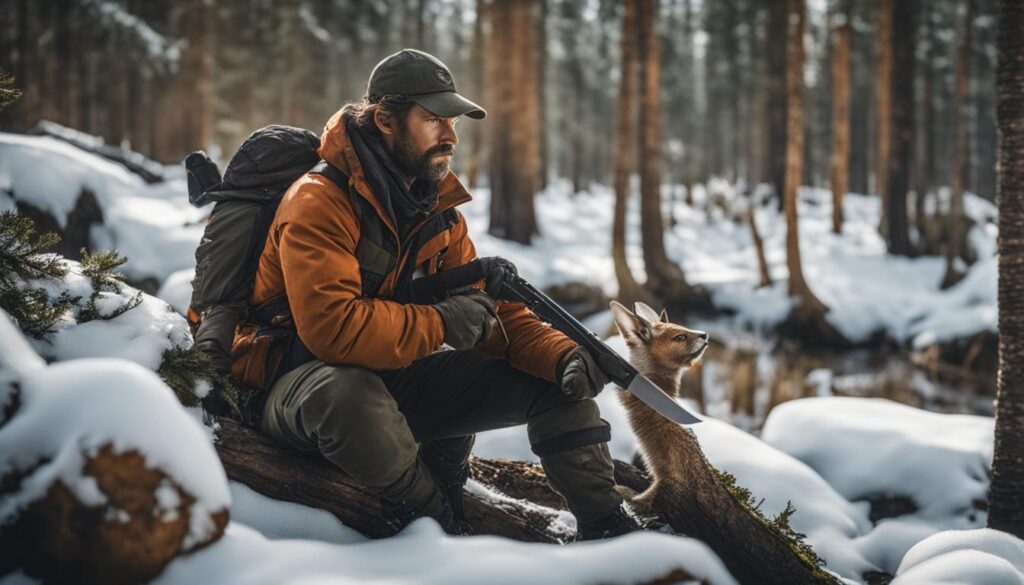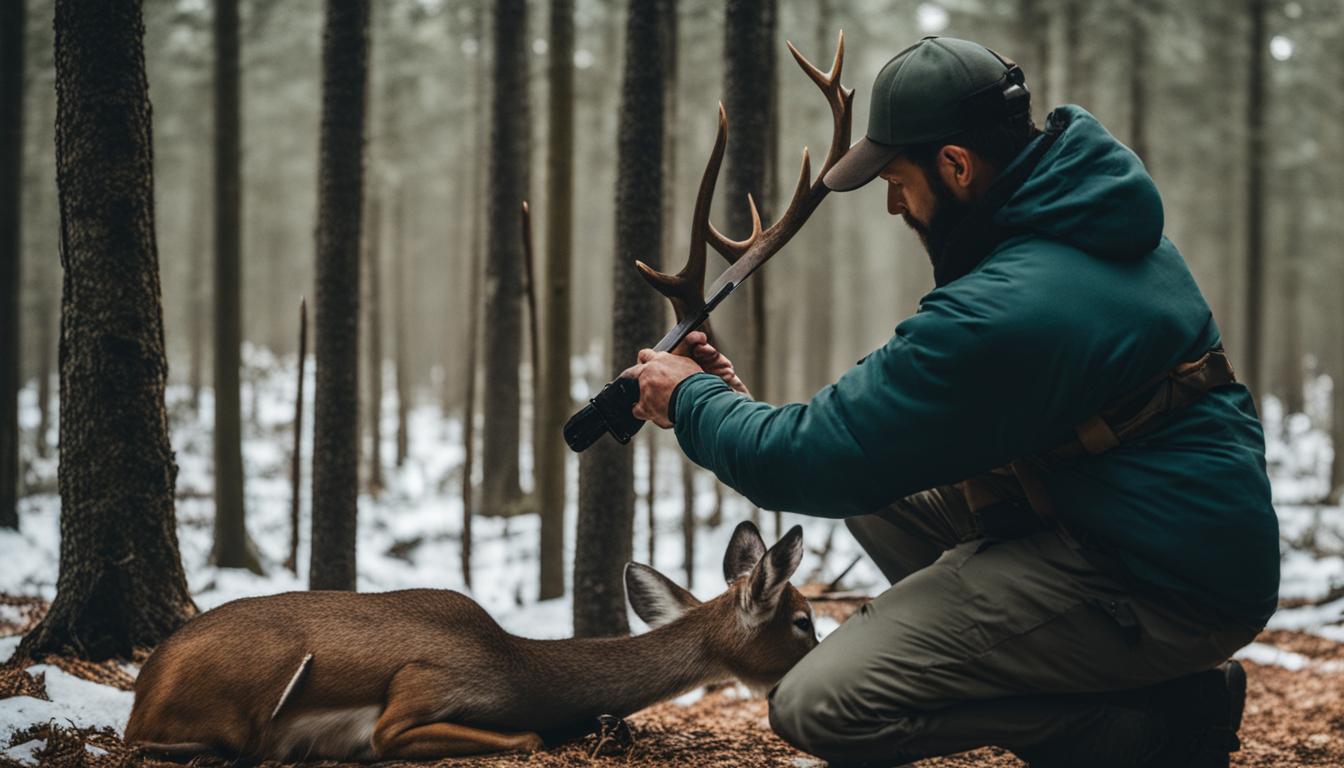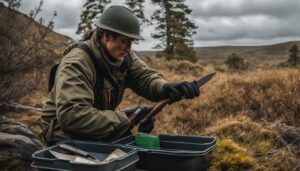When venturing into the great outdoors, it’s important to prioritize safety when handling and using a hunting knife. Follow these essential tips to ensure a safe and enjoyable experience.
Choose a knife that suits your needs and familiarize yourself with its features. Handle the knife with care, using a firm grip and avoiding reckless actions. Carry and store the knife safely in a durable sheath. Be mindful of your surroundings and potential hazards while using the knife. Maintain situational awareness and exercise caution during cutting tasks. Sharpen the knife regularly and follow proper techniques. Use fire safely and be prepared for potential knife-related injuries. Teach proper knife safety to children and supervise their use.
Key Takeaways:
- Choose a hunting knife that is suitable for your specific needs and built to withstand the demands of the wilderness.
- Familiarize yourself with your hunting knife’s features, including the locking mechanism, opening and closing methods, and any additional tools it may have.
- Handle your hunting knife with care, maintaining a firm grip and keeping your fingers away from the blade edge to minimize the risk of accidental cuts.
- Carry and store your hunting knife safely in a durable sheath or designated location to prevent accidents and maintain its longevity.
- Practice proper knife safety techniques, such as cutting away from your body and maintaining situational awareness, to minimize the risk of accidents while using the knife.
Choosing the Right Knife
When it comes to using a hunting knife safely, one of the most crucial factors to consider is choosing the right knife for the job. The right knife can make a significant difference in your outdoor experience, providing you both with the functionality you need and the peace of mind that comes with a reliable tool. When selecting a hunting knife, there are a few key factors to keep in mind.
Firstly, consider the blade length. The blade length should be suitable for the tasks you anticipate performing in the wilderness. A longer blade may be ideal for tasks such as chopping wood or skinning large game, while a shorter blade may be more suitable for precision tasks like field dressing or preparing food.
Next, pay attention to the handle design. The handle should be comfortable to hold and provide a secure grip. Consider the material, shape, and texture of the handle to ensure it meets your preferences and offers optimal control while using the knife.
Lastly, evaluate the locking mechanism. A strong and reliable locking mechanism is important for your safety. It prevents the blade from accidentally closing during use, reducing the risk of injuries. Look for a knife with a robust locking mechanism that you can trust while performing various cutting tasks in the wilderness.
Table: Comparing Blade Length, Handle Design, and Locking Mechanism
| Knife Model | Blade Length | Handle Design | Locking Mechanism |
|---|---|---|---|
| Model A | 4 inches | Ergonomic rubber handle | Lockback mechanism |
| Model B | 6 inches | Wooden handle | Liner lock |
| Model C | 3.5 inches | G10 handle with textured grip | Frame lock |
The table above compares three different knife models based on their blade length, handle design, and locking mechanism. It’s important to carefully assess these features and choose a knife that aligns with your needs, preferences, and the specific requirements of your outdoor adventures. By selecting the right knife, you’ll be equipped with a reliable and functional tool that enhances both your safety and overall experience in the wilderness.
Familiarize Yourself with Your Knife
Before heading into the wilderness, it is crucial to familiarize yourself with the features of your hunting knife. Understanding its locking mechanism, opening and closing methods, and any additional tools it may have will not only help you handle the knife effectively but also reduce the risk of accidents or injuries.
Take the time to practice using your knife safely and confidently before relying on it in the field. This will allow you to become comfortable with its operation and ensure that you are fully aware of how to use it properly. By familiarizing yourself with your knife, you can enhance your overall safety and make the most of your outdoor adventure.
Knife Features
When familiarizing yourself with your hunting knife, pay attention to its unique features. Different knives have various blade designs, handle materials, and ergonomics. Understanding these features will help you choose the right knife for your needs and perform specific tasks effectively.
Locking Mechanism
The locking mechanism is an essential aspect of any folding knife. It holds the blade securely in place when open, preventing accidental closures that could lead to injuries. Familiarize yourself with the locking mechanism of your knife to ensure you can use and close it safely and efficiently.
Opening and Closing Methods
Hunting knives can have different opening and closing methods, such as thumb studs, thumb holes, or assisted opening mechanisms. Understanding how your knife opens and closes will enable you to handle it safely, avoiding any mishaps during use.
Additional Tools
Some hunting knives come with additional tools or features, such as built-in fire starters, screwdrivers, or bottle openers. Get to know these additional tools and practice using them appropriately. They can come in handy during your outdoor adventures and enhance the versatility of your knife.

In summary, familiarizing yourself with your hunting knife is crucial for ensuring safe and efficient use in the wilderness. Take the time to understand its features, locking mechanism, opening and closing methods, and any additional tools it may have. Practice using your knife safely before heading out into the field. By doing so, you can minimize the risk of accidents and fully leverage the capabilities of your knife during your outdoor pursuits.
Proper Handling Techniques
When it comes to using a hunting knife, proper handling is key to ensuring safety and control. By following a few important guidelines, you can minimize the risk of accidents and make the most of your outdoor experience.
First and foremost, always handle the knife with care. This means treating it with respect and using a firm grip to maintain control. Avoid reckless actions or unnecessary knife movements that could lead to injuries. Remember, a hunting knife is a tool that requires precision and attention.
Finger safety is another crucial aspect of proper handling. Keep your fingers away from the blade edge at all times to minimize the risk of accidental cuts. Maintaining a secure grip and being mindful of your fingers’ position will help you maintain control and ensure safe use.
Table: Proper Handling Techniques
| Technique | Description |
|---|---|
| Handle with Care | Treat the knife with respect, avoiding reckless actions that could lead to injuries. |
| Firm Grip | Hold the knife with a firm grip to maintain control and minimize the risk of accidents. |
| Finger Safety | Keep your fingers away from the blade edge to prevent accidental cuts. |
| Control During Use | Exercise caution and maintain control while using the knife to ensure safe and efficient use. |
Lastly, control during use is essential for safe handling. Always be in control of the knife’s movements, cutting away from your body and maintaining a safe distance from others. This helps minimize the risk of accidental injuries in case of slippage or loss of control.
By practicing proper handling techniques, such as handling the knife with care, maintaining a firm grip, prioritizing finger safety, and exercising control during use, you can ensure safe and effective use of your hunting knife in the wilderness.
Carrying and Storing Safely
When it comes to carrying and storing your hunting knife, safety should always be a top priority. Properly securing your knife ensures not only your own protection but also prevents any accidental openings or damage. Here are some essential tips to help you carry and store your hunting knife safely.
Secure Storage
A durable sheath is an indispensable accessory when it comes to safely carrying and storing your hunting knife. Look for a sheath that provides a snug fit, ensuring the knife is securely held in place. This will minimize the risk of accidental openings and prevent the blade from becoming exposed, reducing the likelihood of injuries.
Prevent Accidental Openings
One of the key elements of carrying and storing your knife safely is to make sure it won’t accidentally open while in transit. Check that the sheath has a reliable and secure closure mechanism to keep the knife firmly in place. It’s also important to regularly inspect the sheath for any signs of wear or damage that may compromise its effectiveness.
Transportation Safety
During transportation, always keep your hunting knife in a designated and secure location, such as a backpack or a specially designed knife case. This will minimize the risk of accidental contact with the blade and ensure that the knife remains protected from the elements. Additionally, make sure the knife is safely secured within the storage area to prevent it from shifting or falling out during movement.
| Carrying and Storing Tips | Benefits |
|---|---|
| Use a durable sheath | Securely holds the knife, preventing accidental openings and injuries |
| Regularly inspect the sheath | Identify any wear or damage that may compromise its effectiveness |
| Keep the knife in a designated location | Minimizes the risk of accidental contact with the blade and exposure to the elements |
| Safely secure the knife during transportation | Prevents shifting or falling out, ensuring safety and protection |
By following these guidelines for carrying and storing your hunting knife, you can ensure that it remains safe and in optimal condition for your outdoor adventures. Remember, a well-protected and securely stored knife not only protects you but also prolongs the lifespan of your valuable tool.
Knife Safety Practices
When using a hunting knife, it is essential to prioritize safety by practicing proper knife safety techniques. By following these guidelines, you can minimize the risk of accidents and ensure a safe outdoor experience.
Knife Safety Awareness
One of the most important aspects of knife safety is maintaining situational awareness. Always be aware of your surroundings, including potential hazards and the presence of others. Avoid using a knife in situations that could endanger yourself or those nearby. By staying alert and cautious, you can prevent accidents and promote a safe environment.
Cutting Techniques
Proper cutting techniques are crucial for knife safety. When using a hunting knife, it is essential to cut away from your body to minimize the risk of accidental injury in case of slippage or loss of control. Whether you are preparing food, building shelter, or engaging in other cutting tasks, always maintain a safe distance from yourself and others.
Cutting Away from the Body
When using a hunting knife, it is crucial to cut away from your body. This practice minimizes the risk of accidental injury in case of slippage or loss of control. By cutting away from yourself, you can ensure that any potential mishaps pose less risk to yourself and those around you.
Practicing knife safety is essential to ensure a safe and enjoyable outdoor experience. By maintaining situational awareness, using proper cutting techniques, and cutting away from your body, you can minimize the risk of accidents and promote a safe environment. Remember to always prioritize safety when using a hunting knife.


Conclusion
As I conclude this guide on hunting knife safety, it’s clear that prioritizing safe knife handling is essential for any outdoor adventure. By following these tips and techniques, you can ensure a secure and enjoyable experience in the wilderness.
Remember, selecting the right knife for your needs is the first step towards safety. Familiarize yourself with its features, handle it with care, and store it securely in a durable sheath. These precautions will help prevent accidents and keep you and others protected.
Additionally, practicing proper knife safety techniques and maintaining situational awareness are essential. Always cut away from your body, be mindful of your surroundings, and avoid reckless actions. By doing so, you can reduce the risk of injuries and make the most of your outdoor adventures.
So, whether you’re an experienced hunter or a beginner setting out on your first expedition, remember these knife safety tips. By respecting the power of the hunting knife and prioritizing safety, you can enjoy a successful and memorable time in the great outdoors.
FAQ
Why is it important to choose the right hunting knife?
Choosing the right hunting knife is crucial for ensuring safe and effective use in the wilderness. It provides the necessary functionality for your specific needs and can withstand the demands of outdoor activities.
How can I familiarize myself with my hunting knife?
To become familiar with your hunting knife, learn about its features, including the locking mechanism, opening and closing methods, and any additional tools it may have. Practice using the knife safely and confidently before relying on it in the field.
How should I handle a hunting knife?
Always handle a hunting knife with a firm grip, keeping your fingers away from the blade edge. This allows you to maintain control and minimize the risk of accidental cuts. Avoid reckless or unnecessary knife actions that could lead to injuries.
How should I carry and store my hunting knife?
Carry and store your hunting knife safely by sheathing it or using a secure, designated location. Use a durable sheath that provides adequate protection for both the blade and yourself. Ensure the knife is safely secured and won’t accidentally open or fall out during transportation.
What are some knife safety practices to follow?
When using a hunting knife, be aware of your surroundings and potential hazards. Avoid using a knife in situations that could endanger yourself or others nearby. Always cut away from your body and maintain a safe distance from others.





